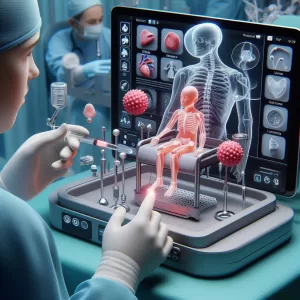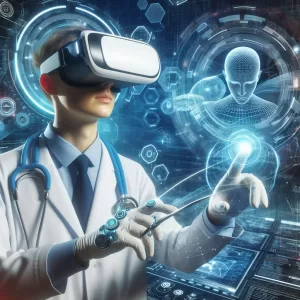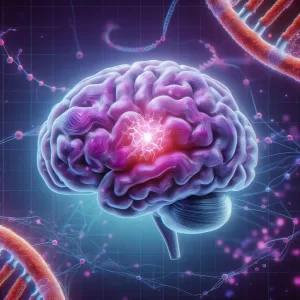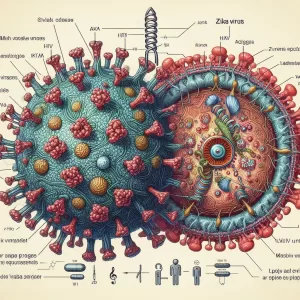In a world where medicine is making great strides, the latest medical advances represent a beacon of hope for humanity. These innovations, which seem straight out of a science fiction novel, have the potential to radically transform our approach to health. From gene editing, which promises to repair defective genes, to 3D printing offering personalized solutions for medical care, including nanomedicine and ultra-targeted treatments, these advances open up new perspectives. Not forgetting the potential impact of virtual and augmented reality in healthcare, offering innovative treatment and training methods.
In this article, we will explore how these advances are tackling some of the biggest challenges in modern medicine, such as Alzheimer’s disease, HIV, Zika virus, heart failure, and cancer. Dive with us into this overview of the technologies shaping the future of medicine.
I. Genetic Editing: A Revolution in Progress.

The year 2023 is shaping up to be a watershed moment for CRISPR gene therapies, potentially marking the entry of this revolutionary technology into the clinical domain. Expectations are particularly high following the announcement of the first approval decision for a CRISPR gene therapy, setting the stage for future regulatory approvals. This anticipation follows years of research and development, culminating in the awarding of the Nobel Prize in Chemistry in 2020 to Jennifer Doudna and Emmanuelle Charpentier for their work on CRISPR.
1. Clinical Advances and Therapeutic Potential:
Ongoing clinical trials illustrate the breadth of CRISPR’s potential applications, ranging from treating blood diseases like sickle cell disease (SCD) and transfusion-dependent beta-thalassemia (TBT) to innovative approaches in the fight against cancer. Several clinical trials are in phase 1/2, testing CRISPR-based therapies for SCD, using varied techniques such as base editing to induce fetal hemoglobin (HbF) expression, aiming to attenuate the symptoms of the disease. Early results suggest an acceptable safety profile and signs of effectiveness, with patients not experiencing vaso-occlusive crises during the first months of follow-up.
In the oncology field, CRISPR is also at the center of promising research, notably in the development of allogeneic CAR-T cells modified by CRISPR. These therapies aim to make CAR-T cells from healthy donors capable of attacking cancer cells without being rejected by the recipient’s immune system. This approach could revolutionize the treatment of certain cancers, by making CAR-T therapies more accessible and potentially more effective.
2. Regulatory Challenges and Future Outlook:
However, beyond clinical advances, the year 2023 is also crucial for establishing a regulatory framework for CRISPR-based therapies. Regulatory clarity is essential for the future development of this technology, as it will guide how these therapies are evaluated, approved, and made available to patients. Collaboration between biotechnology companies and regulators will be key to maintaining the momentum of this innovation.
CRISPR treatments for blood diseases have led the way in clinical success, demonstrating the potential of CRISPR to bring breakthrough treatments for conditions previously considered incurable. These advances highlight the possibility of a “cure” or very close to cure treatment for genetic diseases through the modified expression of key genes.
The year 2023 could therefore mark the start of a new era in the treatment of genetic diseases and cancer, with CRISPR playing a central role in these advances. Attention is focused not only on clinical trial results and imminent regulatory approvals but also on establishing a suitable regulatory and pricing framework for these innovative therapies, which could shape the future of genomic medicine.
II. 3D Printing: Personalization of Medical Care.

The spectacular advancement of 3D printing in the health sector constitutes a revolution that is profoundly changing medical practices. By providing the ability to create custom medical devices, this technology marks the start of a new era in the personalization of medical care.
1. Custom-made prostheses: A Revolution in the World of Orthopedics.
One of the most significant contributions of 3D printing is its ability to manufacture prostheses perfectly adapted to the individual needs of patients. Traditionally, prosthetics were standardized, often requiring adjustments that could be uncomfortable for the user. With 3D printing, each prosthesis can be designed to precisely fit the patient’s body shape, providing increased comfort and functionality. This personalization pushes the limits of what is possible in orthopedics, even allowing the creation of prosthetics aesthetically similar to lost limbs, thus improving the quality of life of patients.
2. Anatomical Models for Surgical Planning:
Beyond prosthetics, 3D printing is also transforming preparation for surgical procedures. Surgeons can now use 3D-printed anatomical models that faithfully reproduce the patient’s characteristics. These models allow much more precise surgical planning and can significantly reduce the risks during operations. By practicing on exact replicas of the organs they will operate on, surgeons can anticipate potential complications and choose the best surgical approach, making procedures safer and more effective.
3. Towards Organ and Tissue Printing:
Perhaps the most futuristic and promising aspect of 3D printing in medicine is the potential development of printing living organs and tissues. Although this technology is still in its infancy, advances in 3D bioprinting suggest a future where it may be possible to produce functional organs for transplants. This could solve the problem of a shortage of organs available for transplants and reduce the risk of rejection since the organs could be created from the patient’s cells.
4. Impact on Patient Care:
The impact of 3D printing on medical care is vast. In addition to improving the efficiency of surgical procedures and reducing risks for patients, this technology has the potential to democratize access to high-quality healthcare. Custom-made prosthetics and medical equipment, once expensive and difficult to obtain, can now be produced at a significantly lower cost, making advanced treatments accessible to more people.
In summary, 3D printing is redefining the landscape of medical care, paving the way for more personalized, effective, and accessible treatments. As this technology continues to evolve, its potential to further revolutionize the medical field only grows, promising significant advancements in the way we approach patient care and treatment.
III. Nanomedicine: Towards More Targeted Treatments.

Nanomedicine, at the forefront of biomedical innovation, represents a revolution in the way we design and administer medical treatments. By harnessing the power of nanotechnology, this field promises to radically transform healthcare, particularly in the fight against complex diseases such as cancer, cardiovascular disease, and neurodegenerative disorders.
1. Nanoparticles: Precision Vectors for Drug Delivery.
At the heart of nanomedicine are nanoparticles, extremely small structures capable of passing through the human body in a precise and controlled manner. Their size, measured in nanometers (a nanometer is a billionth of a meter), allows them to interact directly with biological cells. This opens up new possibilities for drug delivery, allowing researchers to design delivery systems that specifically target diseased cells, thereby minimizing the impact on surrounding healthy tissues.
2. Improved Effectiveness and Reduced Side Effects:
One of the main advantages of nanomedicine is its ability to improve the effectiveness of treatments. For example, in the case of chemotherapy, nanoparticles can be used to deliver anti-cancer drugs directly to cancer cells, thereby reducing the amount of drug needed and, therefore, side effects for the patient. This targeted approach means that medicines can work more effectively on the disease while preserving patients’ quality of life through a significant reduction in harmful side effects.
3. Applications in Diagnostics and Targeted Therapies:
Beyond drug delivery, nanomedicine plays a crucial role in diagnosis and targeted therapies. Nanoparticles can be designed to bind to specific cells or molecules, allowing doctors to detect diseases at a much earlier stage than traditional methods. Additionally, some nanoparticles are used to enhance medical imaging, such as in the case of magnetic resonance imaging (MRI), where they act as high-precision contrast agents, improving image quality and accuracy. diagnostic.
4. Advances in the Fight Against Cancer:
The fight against cancer particularly benefits from progress in nanomedicine. Treatments can be designed to specifically disrupt the cellular processes of cancer cells, preventing their growth and proliferation without damaging healthy cells. Researchers are also exploring the use of nanoparticles for thermal tumor treatment, where the particles are heated in a controlled manner, killing cancer cells with remarkable precision.
5. Towards a Future of Personalized Treatments:
Nanomedicine opens the way to highly personalized treatments, adapted to the genetic and molecular specificities of each patient. This personalization of treatments promises not only to improve their effectiveness but also to reduce the risk of side effects, marking a giant step towards more humane and patient-centered medicine.
In summary, nanomedicine is transforming the way we think about treating disease, providing safer, more effective, and more targeted methods. As research in this area continues to advance, the future of nanomedicine promises even more dramatic advances, with the potential to defeat some of the most feared diseases of our time.
IV. Virtual and Augmented Reality: A New Dimension of Healthcare.

The integration of virtual reality (VR) and augmented reality (AR) technologies in healthcare is an emerging trend that promises to transform the way care is delivered, taught, and experienced. These technologies, once relegated to the field of entertainment, are now finding revolutionary applications in the medical sector, offering new perspectives for improving the quality and efficiency of care.
1. Medical Education and Surgical Training:
One of the most promising applications of VR and AR is in medical education and surgical training. Through immersive simulations, medical students and surgeons in training can practice complex procedures in a controlled environment without any risk to patients. This hands-on learning method promotes a faster learning curve and a better understanding of medical procedures. Additionally, it allows healthcare professionals to repeat the same procedures until complete mastery, significantly improving their skills and confidence.
2. Pain Management and Rehabilitation:
VR and AR have also shown significant potential in pain management and patient rehabilitation. For example, VR applications are used to distract patients during painful procedures or as a therapy tool for people suffering from chronic pain. By creating a calming or distracting virtual environment, patients can experience a reduction in pain perception. For rehabilitation, VR and AR can simulate activities of daily living, helping patients recover motor skills after a stroke or injury, and making rehabilitation more interactive and engaging.
3. Improvement of Complex Procedures:
AR technologies in particular have found their place in improving complex surgical procedures. By superimposing digital images or specific patient data directly into the surgeon’s field of view, AR can provide critical information in real time during operations. This includes displaying hidden anatomical structures or precise navigation during minimally invasive procedures, thereby improving surgical precision and potentially reducing patient recovery times.
4. Impact on Patient Outcomes:
The adoption of VR and AR in healthcare has a direct impact on improving patient outcomes. By offering more advanced training methods for healthcare professionals, these technologies contribute to safer and more effective procedures. For patients, access to innovative pain management tools and interactive rehabilitation programs can speed recovery and improve quality of life.
5. Towards a Future of Immersive Healthcare:
The future of healthcare, shaped by VR and AR, looks promising. As these technologies continue to evolve, their integration into everyday medical practice will become more common, paving the way for even more immersive and personalized healthcare experiences. The possibilities are vast, from advanced medical training to groundbreaking surgical procedures and innovative rehabilitation strategies, all aimed at improving the health and well-being of patients around the world.
V. Alzheimer and Brain:

Alzheimer’s disease research and understanding of the human brain are at the heart of a scientific revolution, offering new hope for the treatment of this devastating neurodegenerative condition and other cognitive disorders. Thanks to significant advances in the understanding of brain biology and the development of innovative therapies, we are approaching a future where Alzheimer’s could be significantly controlled or even cured.
1. Progress in Understanding Alzheimer’s Disease:
Recent research has greatly improved our understanding of Alzheimer’s disease, identifying the underlying biological and genetic mechanisms that contribute to its development. The discovery of specific biomarkers and genes associated with Alzheimer’s has been crucial, enabling early detection and a better understanding of individual risks. These genetic advances open promising perspectives for the development of personalized prevention strategies, targeting high-risk individuals well before the appearance of symptoms.
2. Development of New Drugs:
The therapeutic landscape for Alzheimer’s disease is also changing. New drugs, specifically targeting the pathological mechanisms of the disease, such as the abnormal accumulation of beta-amyloid and tau proteins in the brain, are being developed and tested. These treatments aim to slow or even stop the progression of the disease, offering considerable hope for the millions of affected people and their families. Although the road to a complete cure is still long, these advances mark significant steps toward controlling this complex condition.
3. Renewal of Neurons and Immune System:
Recent findings challenge the old belief that neurons do not regenerate. Research has shown that the brain has some capacity for neuronal renewal, opening avenues for regenerative therapies that could restore lost cognitive functions. At the same time, the integration of the brain with the immune system highlights the importance of inflammation and the immune response in neurodegenerative diseases, providing new targets for treatments.
4. Implications for Neurological Treatments:
These advances are not limited to the fight against Alzheimer’s. They have broad implications for the treatment of a range of neurological conditions, including Parkinson’s disease, multiple sclerosis, and traumatic brain injury. By better understanding how the brain repairs itself and interacts with the immune system, scientists can develop strategies to improve neuronal and cognitive recovery after damage or in degenerative diseases.
5. Towards a Future Without Alzheimer’s:
The convergence of genetics, pharmacology, and neuroscience opens promising avenues to conquer Alzheimer’s and other neurodegenerative disorders. By continuing to decipher the mysteries of the brain and developing more effective treatments, we are moving towards a future where brain diseases could be managed much more effectively, or even eradicated. The road is still long and fraught with obstacles, but the progress made so far provides a solid basis for optimism and continued research in this crucial direction for human health.
VI. HIV and Zika Virus:

The global fight against viruses and infectious diseases, including HIV and the Zika virus, has reached significant milestones thanks to innovative medical advances. These advances not only offer new hope for the management and treatment of these infections but also improve the capacity to respond to emerging viral threats.
1. Progress in the Fight against HIV:
HIV, long considered a death sentence, is now manageable thanks to significant advances in treatment options. Expanded access to triple therapy, a combination of antiretroviral drugs, has transformed HIV into a manageable chronic condition for many people living with the virus. This evolution is the direct result of decades of research and development, resulting in treatments that are more effective, less toxic, and easier to take, often reduced to one pill per day.
Additionally, scientists are working on innovative treatments, such as gene therapy and therapeutic vaccines, that promise to further revolutionize HIV treatment by boosting patients’ immune systems or eliminating the virus from their bodies. Although these approaches are still being studied, they represent a horizon of hope for the potential eradication of HIV.
2. Response to Emerging Viruses: The Case of Zika.
The Zika virus, which emerged as a global health threat in 2015, catalyzed a rapid response from the scientific community. Researchers have developed rapid diagnostic tests, enabling effective identification of infections and facilitating the implementation of epidemic control measures. At the same time, considerable effort has been devoted to the development of Zika vaccines, with several candidates currently in clinical trials. These initiatives reflect an increased ability to respond quickly to new viral threats, a crucial element in a globalized world where viruses can spread quickly across continents.
3. Impact on Quality of Life and Public Health:
Improving access to treatment for HIV and progress in combating emerging viruses like Zika is having a profound impact on the quality of life of those affected and overall public health. People living with HIV can now look forward to long and productive lives, while advances in understanding and managing emerging viruses strengthen health systems and capacity to respond to epidemics.
4. Towards a Future Without HIV and Other Emerging Viruses:
Although challenges remain, particularly in terms of universal access to treatments and the development of effective vaccines against viruses like Zika, the current direction of medical research and innovations is promising. The ultimate goal remains the eradication of HIV and the ability to prevent or rapidly contain emerging viruses, thereby safeguarding the health and well-being of populations across the world.
In summary, progress in the fight against HIV and response to emerging viruses demonstrates the incredible potential of medical science to turn health challenges into success stories. With continued research, investment, and international cooperation, the future of public health in the face of these viral threats looks more promising than ever.
VII. Heart Failure:

Heart failure is a complex condition where the heart does not pump blood as efficiently as it should, which can lead to a variety of symptoms, including fatigue, shortness of breath, and fluid buildup in the limbs and limbs. lungs. Management and diagnosis of this condition involve a combination of medications, lifestyle changes, and increasingly, the use of advanced technologies.
1. Sensors and Connected Devices:
Sensors and connected devices play a transformative role in monitoring heart failure. These technologies enable real-time home monitoring, providing patients and healthcare professionals a constant window into the patient’s cardiac functioning. For example, wearable monitoring devices can detect subtle variations in heart rate, blood pressure, and even blood composition, providing early alerts that can prevent hospitalizations.
2. Telemedicine:
Telemedicine represents another crucial technological pillar in the management of heart failure. It allows patients to consult their doctors remotely, thus facilitating regular monitoring without the constraints and risks associated with frequent hospital visits. This is particularly beneficial for patients living in remote areas or having difficulty traveling.
3. Artificial Intelligence and Data Analysis:
Artificial intelligence (AI) and data analytics are at the heart of the next generation of heart failure care. AI can analyze huge volumes of data from connected devices to identify predictive patterns of health decline, enabling proactive interventions. These technologies can also help personalize treatments, adjusting therapies and medications based on each patient’s specific responses and needs.
VIII. Cancer:

In the ongoing fight against cancer, a multifaceted disease that affects millions of people each year, technological innovation, particularly artificial intelligence (AI), is emerging as a ray of hope. AI, with its ability to process and analyze massive amounts of data at unprecedented speed and precision, is radically transforming the way we diagnose and treat cancer.
1. The Diagnostic Power of AI:
One of the major challenges in the fight against cancer is early and accurate diagnosis. Artificial intelligence comes into play by analyzing large sets of medical data, including x-ray images, genetic testing, and electronic health records, to identify signs of cancer that are often imperceptible to the human eye. This analysis makes it possible to evaluate the aggressiveness of a tumor, predict the risks of recurrence, and determine the potential response to different treatments.
2. Innovative Technologies:
Among emerging technologies, the SpiderMass non-invasive molecular analysis device stands out. It promises to revolutionize diagnosis by allowing the identification of cancer cells in real-time, without the need for surgical interventions. This method promises more accurate, faster, and significantly less invasive diagnoses, reducing stress and anxiety for patients while improving treatment outcomes.
3. Personalization of Treatment:
Beyond diagnosis, AI helps personalize cancer treatment. By analyzing the specific characteristics of a patient’s tumor and comparing them against large databases of treatments and patient responses, AI can recommend the most effective and least toxic treatment strategies for each individual. This tailored approach maximizes the chances of treatment success while minimizing side effects.
4. Challenges and Perspectives:
Despite its potential, the integration of AI into clinical practice faces challenges, particularly in terms of regulation, protection of personal data, and training of healthcare professionals. Nonetheless, advances continue apace, promising a future where cancer can be detected and treated with unprecedented precision.
In summary, artificial intelligence represents a breakthrough in the fight against cancer, offering hope and promise of increased efficiency in diagnosis and treatment. As we continue to explore and develop these technologies, the ultimate goal remains the same: to save lives and improve the quality of life of patients everywhere.
Conclusion :
The latest medical advances offer a window into a future where diseases, once considered incurable or difficult to treat, may become memories of the past. Gene editing, 3D printing, nanomedicine, as well as the use of virtual and augmented reality, show that we are at the dawn of a medical revolution. These technologies not only hold promise for treating specific diseases such as Alzheimer’s, HIV, Zika, heart failure, and cancer, but also pave the way for a more personalized and effective approach to care. health. As we continue to navigate this new age of medical innovation, it is crucial to consider the ethical implications and implementation challenges to ensure that these advances benefit everyone. The future of medicine is bright, full of promise and hope, propelled by the incredible technological advances we are experiencing today.
Guest Article
Written by S.M.B

